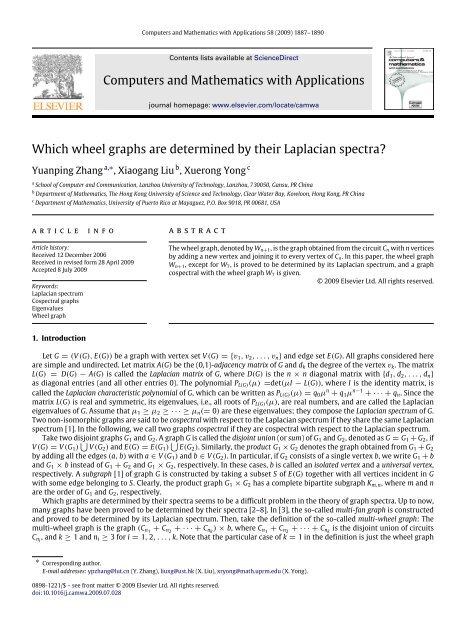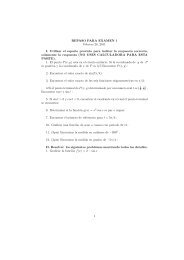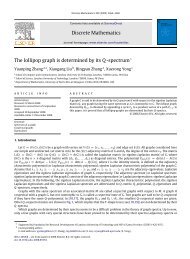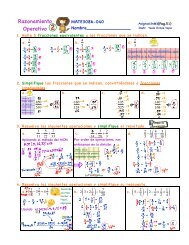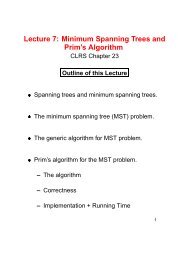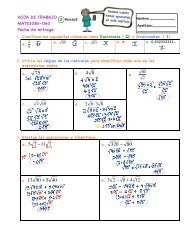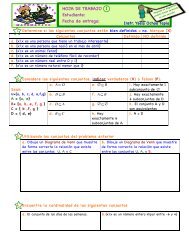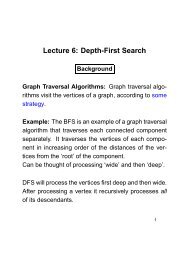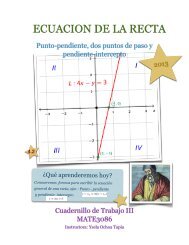Which wheel graphs are determined by their Laplacian ... - UPRM
Which wheel graphs are determined by their Laplacian ... - UPRM
Which wheel graphs are determined by their Laplacian ... - UPRM
You also want an ePaper? Increase the reach of your titles
YUMPU automatically turns print PDFs into web optimized ePapers that Google loves.
Computers and Mathematics with Applications 58 (2009) 1887–1890<br />
Contents lists available at ScienceDirect<br />
Computers and Mathematics with Applications<br />
journal homepage: www.elsevier.com/locate/camwa<br />
<strong>Which</strong> <strong>wheel</strong> <strong>graphs</strong> <strong>are</strong> <strong>determined</strong> <strong>by</strong> <strong>their</strong> <strong>Laplacian</strong> spectra?<br />
Yuanping Zhang a,∗ , Xiaogang Liu b , Xuerong Yong c<br />
a School of Computer and Communication, Lanzhou University of Technology, Lanzhou, 730050, Gansu, PR China<br />
b Department of Mathematics, The Hong Kong University of Science and Technology, Clear Water Bay, Kowloon, Hong Kong, PR China<br />
c Department of Mathematics, University of Puerto Rico at Mayaguez, P.O. Box 9018, PR 00681, USA<br />
a r t i c l e<br />
i n f o<br />
a b s t r a c t<br />
Article history:<br />
Received 12 December 2006<br />
Received in revised form 28 April 2009<br />
Accepted 8 July 2009<br />
Keywords:<br />
<strong>Laplacian</strong> spectrum<br />
Cospectral <strong>graphs</strong><br />
Eigenvalues<br />
Wheel graph<br />
The <strong>wheel</strong> graph, denoted <strong>by</strong> W n+1 , is the graph obtained from the circuit C n with n vertices<br />
<strong>by</strong> adding a new vertex and joining it to every vertex of C n . In this paper, the <strong>wheel</strong> graph<br />
W n+1 , except for W 7 , is proved to be <strong>determined</strong> <strong>by</strong> its <strong>Laplacian</strong> spectrum, and a graph<br />
cospectral with the <strong>wheel</strong> graph W 7 is given.<br />
© 2009 Elsevier Ltd. All rights reserved.<br />
1. Introduction<br />
Let G = (V(G), E(G)) be a graph with vertex set V(G) = {v 1 , v 2 , . . . , v n } and edge set E(G). All <strong>graphs</strong> considered here<br />
<strong>are</strong> simple and undirected. Let matrix A(G) be the (0,1)-adjacency matrix of G and d k the degree of the vertex v k . The matrix<br />
L(G) = D(G) − A(G) is called the <strong>Laplacian</strong> matrix of G, where D(G) is the n × n diagonal matrix with {d 1 , d 2 , . . . , d n }<br />
as diagonal entries (and all other entries 0). The polynomial P L(G) (µ) =det(µI − L(G)), where I is the identity matrix, is<br />
called the <strong>Laplacian</strong> characteristic polynomial of G, which can be written as P L(G) (µ) = q 0 µ n + q 1 µ n−1 + · · · + q n . Since the<br />
matrix L(G) is real and symmetric, its eigenvalues, i.e., all roots of P L(G) (µ), <strong>are</strong> real numbers, and <strong>are</strong> called the <strong>Laplacian</strong><br />
eigenvalues of G. Assume that µ 1 ≥ µ 2 ≥ · · · ≥ µ n (= 0) <strong>are</strong> these eigenvalues; they compose the <strong>Laplacian</strong> spectrum of G.<br />
Two non-isomorphic <strong>graphs</strong> <strong>are</strong> said to be cospectral with respect to the <strong>Laplacian</strong> spectrum if they sh<strong>are</strong> the same <strong>Laplacian</strong><br />
spectrum [1]. In the following, we call two <strong>graphs</strong> cospectral if they <strong>are</strong> cospectral with respect to the <strong>Laplacian</strong> spectrum.<br />
Take two disjoint <strong>graphs</strong> G 1 and G 2 . A graph G is called the disjoint union (or sum) of G 1 and G 2 , denoted as G = G 1 + G 2 , if<br />
V(G) = V(G 1 ) ⋃ V(G 2 ) and E(G) = E(G 1 ) ⋃ E(G 2 ). Similarly, the product G 1 × G 2 denotes the graph obtained from G 1 + G 2<br />
<strong>by</strong> adding all the edges (a, b) with a ∈ V(G 1 ) and b ∈ V(G 2 ). In particular, if G 2 consists of a single vertex b, we write G 1 + b<br />
and G 1 × b instead of G 1 + G 2 and G 1 × G 2 , respectively. In these cases, b is called an isolated vertex and a universal vertex,<br />
respectively. A subgraph [1] of graph G is constructed <strong>by</strong> taking a subset S of E(G) together with all vertices incident in G<br />
with some edge belonging to S. Clearly, the product graph G 1 × G 2 has a complete bipartite subgraph K m,n , where m and n<br />
<strong>are</strong> the order of G 1 and G 2 , respectively.<br />
<strong>Which</strong> <strong>graphs</strong> <strong>are</strong> <strong>determined</strong> <strong>by</strong> <strong>their</strong> spectra seems to be a difficult problem in the theory of graph spectra. Up to now,<br />
many <strong>graphs</strong> have been proved to be <strong>determined</strong> <strong>by</strong> <strong>their</strong> spectra [2–8]. In [3], the so-called multi-fan graph is constructed<br />
and proved to be <strong>determined</strong> <strong>by</strong> its <strong>Laplacian</strong> spectrum. Then, take the definition of the so-called multi-<strong>wheel</strong> graph: The<br />
multi-<strong>wheel</strong> graph is the graph (C n1 + C n2 + · · · + C nk ) × b, where C n1 + C n2 + · · · + C nk is the disjoint union of circuits<br />
C ni , and k ≥ 1 and n i ≥ 3 for i = 1, 2, . . . , k. Note that the particular case of k = 1 in the definition is just the <strong>wheel</strong> graph<br />
∗ Corresponding author.<br />
E-mail addresses: ypzhang@lut.cn (Y. Zhang), liuxg@ust.hk (X. Liu), xryong@math.uprm.edu (X. Yong).<br />
0898-1221/$ – see front matter © 2009 Elsevier Ltd. All rights reserved.<br />
doi:10.1016/j.camwa.2009.07.028
1888 Y. Zhang et al. / Computers and Mathematics with Applications 58 (2009) 1887–1890<br />
Fig. 1. The cospectral <strong>graphs</strong> W 7 and G.<br />
W n1 +1 = C n1 × b with n 1 + 1 vertices. In this paper, the <strong>wheel</strong> graph W n+1 , except for W 7 , will be proved to be <strong>determined</strong><br />
<strong>by</strong> its <strong>Laplacian</strong> spectrum. This method is also useful in proving that the multi-<strong>wheel</strong> graph (C n1 + C n2 + · · · + C nk ) × b<br />
is <strong>determined</strong> <strong>by</strong> its <strong>Laplacian</strong> spectrum, where k ≥ 2. Here, we will skip the details of the proof for multi-<strong>wheel</strong> <strong>graphs</strong>.<br />
In [9], a new method (see Proposition 4 in [9]) is pointed out, which can be used to prove that every multi-<strong>wheel</strong> graph<br />
(C n1 + C n2 + · · · + C nk ) × b is <strong>determined</strong> <strong>by</strong> its <strong>Laplacian</strong> spectrum, where k ≥ 2. But, for the <strong>wheel</strong> graph W n+1 , the new<br />
method in [9] is useless.<br />
2. Preliminaries<br />
Some previously established results about the spectrum <strong>are</strong> summarized in this section. They will play an important role<br />
throughout the paper.<br />
Lemma 2.1 ([10]). Let G 1 and G 2 be <strong>graphs</strong> on disjoint sets of r and s vertices, respectively. If µ 1 ≥ µ 2 ≥ · · · ≥ µ r (= 0) and<br />
η 1 ≥ η 2 ≥ · · · ≥ η s (= 0) <strong>are</strong> the <strong>Laplacian</strong> spectra of <strong>graphs</strong> G 1 and G 2 , respectively, then r + s; µ 1 + s, µ 2 + s, . . . , µ r−1 +<br />
s; η 1 + r, η 2 + r, . . . , η s−1 + r; and 0 <strong>are</strong> the <strong>Laplacian</strong> spectra of graph G 1 × G 2 .<br />
Lemma 2.2 ([11]).<br />
(1) Let G be a graph with n vertices and m edges and d 1 ≥ d 2 ≥ · · · ≥ d n its non-increasing degree sequence. Then some of the<br />
coefficients in P L(G) (µ) <strong>are</strong><br />
q 0 = 1; q 1 = −2m; q 2 = 2m 2 − m − 1 n∑<br />
d 2 i<br />
2<br />
;<br />
q n−1 = (−1) n−1 nS(G); q n = 0<br />
where S(G) is the number of spanning trees in G.<br />
(2) For the <strong>Laplacian</strong> matrix of a graph, the number of components is <strong>determined</strong> from its spectrum.<br />
Lemma 2.3 ([12]). Let graph G be a connected graph with n ≥ 3 vertices. Then d 2 ≤ µ 2 .<br />
Lemma 2.4 ([13,11]). Let G be a graph with n ≥ 2 vertices. Then d 1 + 1 ≤ µ 1 ≤ d 1 + d 2 .<br />
i=1<br />
Lemma 2.5 ([14]). If G is a simple graph with n vertices, then m G (n) ≤ ⌊ d n<br />
n−d 1<br />
⌋, where m G (n) is the multiplicity of the eigenvalue<br />
n of L(G) and ⌊x⌋ the greatest integer less than or equal to x.<br />
Lemma 2.6 ([15]). Let G be the complement of a graph G. Let µ 1 ≥ µ 2 ≥ · · · ≥ µ n = 0 and µ 1 ≥ µ 2 ≥ · · · ≥ µ n = 0 be the<br />
<strong>Laplacian</strong> spectra of <strong>graphs</strong> G and G, respectively. Then µ i + µ n−i = n for any i ∈ {1, 2, . . . , n − 1}.<br />
Lemma 2.7 ([16]). Let G be a connected graph on n vertices. Then n is an eigenvalue of <strong>Laplacian</strong> matrix L(G) if and only if G is<br />
the product of two <strong>graphs</strong>.<br />
3. Main results<br />
First, let us check that the <strong>graphs</strong> G and W 7 in Fig. 1 <strong>are</strong> cospectral. By using Maple, the <strong>Laplacian</strong> characteristic<br />
polynomials of the <strong>graphs</strong> G and W 7 <strong>are</strong> both<br />
µ 7 − 24µ 6 + 231µ 5 − 1140µ 4 + 3036µ 3 − 4128µ 2 + 2240µ.<br />
That is, G and W 7 <strong>are</strong> cospectral. Then, we will have the following proposition.<br />
Proposition 3.1. The <strong>wheel</strong> graph W 7 is not <strong>determined</strong> <strong>by</strong> its <strong>Laplacian</strong> spectrum.<br />
Theorem 3.2. The <strong>wheel</strong> graph W n+1 , except for W 7 , is <strong>determined</strong> <strong>by</strong> its <strong>Laplacian</strong> spectrum.
Y. Zhang et al. / Computers and Mathematics with Applications 58 (2009) 1887–1890 1889<br />
Fig. 2. Graph with the degree sequence 4, 4, 4, 3, 3, 2.<br />
Proof. Since the <strong>Laplacian</strong> spectrum of the circuit C n is 2−2 cos 2πi<br />
n<br />
(i = 1, 2, . . . , n), <strong>by</strong> Lemma 2.1, the <strong>Laplacian</strong> spectrum<br />
of W n+1 is 3 − 2 cos 2πi (i = 1, 2, . . . , n − 1), and also 0 and n + 1. Suppose a graph G is cospectral with W n n+1. Lemma 2.2<br />
implies that graph G has n + 1 vertices, 2n edges and one component. Then, <strong>by</strong> Lemma 2.7, G is a product of two <strong>graphs</strong>.<br />
Let d 1 ≥ d 2 ≥ · · · ≥ d n+1 be the non-increasing degree sequence of <strong>graphs</strong> G. By Lemma 2.3, d 2 ≤ µ 2 ≤ 5, i.e., d 2 ≤ 5.<br />
Lemma 2.4 implies that d 1 + 1 ≤ n + 1 ≤ d 1 + d 2 ≤ d 1 + 5, i.e., n − 4 ≤ d 1 ≤ n. Consider the following cases for d 1 .<br />
Case 1. d 1 = n − 4. Since the multiplicity of the µ 1 = n + 1 is 1, <strong>by</strong> Lemma 2.5, 1 ≤ ⌊<br />
n+1−(n−4) ⌋, i.e., d n+1 ≥ 5. Then,<br />
d 2 = d 3 = · · · = ∑ d n = d n+1 = 5, i.e., there exist at least n vertices of degree five in graph G. But, 5n + (n − 4) ≠ 2(2n), a<br />
n+1<br />
contradiction to<br />
i=1 d i = 2m, where m is the number of edges in G.<br />
d<br />
Case 2. d 1 = n − 3. Since the multiplicity of the µ 1 = n + 1 is 1, <strong>by</strong> Lemma 2.5, 1 ≤ ⌊ n+1<br />
n+1−(n−3) ⌋, i.e., d n+1 ≥ 4. Except<br />
for ∑ the vertex of degree d 1 = n − 3, suppose there still exist x 5 vertices of degree five and x 4 vertices of degree four in graph<br />
n+1<br />
G.<br />
i=1 d i = 2m implies the following equations:<br />
{<br />
x5 + x 4 + 1 = n + 1<br />
5x 5 + 4x 4 + (n − 3) = 2 × 2n.<br />
Clearly, x 5 = 3 − n, x 4 = 2n − 3 is the solution of the equations. But x 5 < 0, a contradiction.<br />
d<br />
Case 3. d 1 = n − 2. By Lemma 2.5, 1 ≤ ⌊ n+1<br />
n+1−(n−2) ⌋, i.e., d n+1 ≥ 3. Except for the vertex of degree d 1 = n − 2, suppose<br />
there still exist x 5 vertices of degree five, x 4 vertices of degree four and x 3 vertices of degree three in G. Lemma 2.2 and<br />
∑ n+1<br />
i=1 d i = 2m imply the following equations:<br />
⎧<br />
⎨x 5 + x 4 + x 3 + 1 = n + 1<br />
5x 5 + 4x 4 + 3x 3 + (n − 2) = 2 × 2n<br />
⎩<br />
25x 5 + 16x 4 + 9x 3 + (n − 2) 2 = n 2 + 9n.<br />
Clearly, x 5 = 2n − 9, x 4 = 20 − 4n, x 3 = 3n − 11. For n = 4, x 5 < 0, a contradiction. For n = 5, x 5 = 1, but d 1 = 3 < 5,<br />
a contradiction. For n ≥ 7, x 4 < 0, a contradiction.<br />
d<br />
Case 4. d 1 = n − 1. By Lemma 2.5, 1 ≤ ⌊ n+1<br />
n+1−(n−1) ⌋, i.e., d n+1 ≥ 2. Except for the vertex of degree d 1 = n − 1, suppose<br />
that there still exist x 5 vertices of ∑ degree five, x 4 vertices of degree four, x 3 vertices of degree three and x 2 vertices of degree<br />
n+1<br />
two in graph G. Lemma 2.2 and<br />
i=1 d i = 2m imply the following equations:<br />
⎧<br />
⎨x 5 + x 4 + x 3 + x 2 + 1 = n + 1<br />
5x 5 + 4x 4 + 3x 3 + 2x 2 + (n − 1) = 2 × 2n<br />
⎩<br />
25x 5 + 16x 4 + 9x 3 + 4x 2 + (n − 1) 2 = n 2 + 9n.<br />
By solving these equations, x 4 = n − 3 − 3x 5 , x 3 = 7 − n + 3x 5 , x 2 = n − 4 − x 5 , where x 5 is an integer. And<br />
x 2 ≥ 0, x 3 ≥ 0, x 4 ≥ 0 imply that max{ n−7 , 0} ≤ x 3 5 ≤ min{ n−3<br />
n−3<br />
, n − 4}. Clearly, < n − 4 for n ≥ 5. Therefore, if<br />
3 3<br />
n ≥ 5, then x 2 > 0, i.e., there must exist vertices of degree two in graph G. Note that G is a product of two <strong>graphs</strong> and G has<br />
a complete bipartite subgraph K m1 ,m 2<br />
, where m 1 + m 2 = n + 1. Then, for n ≥ 5, the existence of vertices with degree two<br />
implies that the complete bipartite subgraph K m1 ,m 2<br />
is K n−1,2 or K n,1 . But for K m1 ,m 2<br />
= K n,1 , there will exist a vertex with<br />
degree n in graph G, a contradiction to d 1 = n − 1. For n ≥ 7, K n−1,2 implies that there at least exist two vertices with degree<br />
no less than n − 1, a contradiction. Consider the following cases for x 5 and n ≤ 5.<br />
Case 4.1. x 5 = 0. Clearly, x 4 = n − 3, x 3 = 7 − n, x 2 = n − 4. Consider the following cases.<br />
Case 4.1.1. n = 3. Clearly, x 2 = −1 < 0, a contradiction.<br />
Case 4.1.2. n = 4. Clearly, d 1 = 3, x 4 = 1, x 3 = 3, x 2 = 0, but d 1 = 3 < 4, a contradiction.<br />
Case 4.1.3. n = 5. Clearly, d 1 = 4, x 4 = 2, x 3 = 2, x 2 = 1, i.e., there exist three vertices of degree four, two vertices of<br />
degree three and one vertex of degree two in graph G. All the <strong>graphs</strong> with three vertices of degree four, two vertices of degree<br />
three and one vertex of degree two and with complete bipartite subgraph K 2,4 have been enumerated; they <strong>are</strong> isomorphic<br />
to the graph shown in Fig. 2. By using Maple, the <strong>Laplacian</strong> characteristic polynomials of the <strong>graphs</strong> G and W 6 <strong>are</strong><br />
P L(G) (µ) = µ 6 − 20µ 5 + 155µ 4 − 580µ 3 + 1044µ 2 − 720µ,<br />
P L(W6 )(µ) = µ 6 − 20µ 5 + 155µ 4 − 580µ 3 + 1045µ 2 − 726µ.<br />
Clearly, they have different <strong>Laplacian</strong> characteristic polynomials, a contradiction.<br />
d n+1
1890 Y. Zhang et al. / Computers and Mathematics with Applications 58 (2009) 1887–1890<br />
Case 4.2. x 5 ≥ 1. Clearly, for 3 ≤ n ≤ 5, x 4 = n − 3 − 3x 5 < 0, a contradiction.<br />
Case 5. d 1 = n. Since both G and W n+1 have the largest degree n, W n+1 = C n + b and G = G ′ + b, where G ′ is an unknown<br />
graph. Lemma 2.6 implies that G and W n+1 <strong>are</strong> cospectral, i.e., C n and G ′ <strong>are</strong> cospectral. Since the circuit C n is <strong>determined</strong> <strong>by</strong><br />
its <strong>Laplacian</strong> spectrum [6], so is its complement C n . Then, G ′ is isomorphic to C n , i.e., G is isomorphic to W n+1 . Therefore G is<br />
isomorphic to W n+1 . □<br />
For a graph, its <strong>Laplacian</strong> eigenvalues determine the eigenvalues of its complement [15], so the complements of all the<br />
<strong>wheel</strong> <strong>graphs</strong> W n+1 , except for W 7 , <strong>are</strong> <strong>determined</strong> <strong>by</strong> <strong>their</strong> <strong>Laplacian</strong> spectra.<br />
4. Conclusion<br />
In this paper, the <strong>wheel</strong> graph W n+1 , except for W 7 , is proved to be <strong>determined</strong> <strong>by</strong> its <strong>Laplacian</strong> spectrum <strong>by</strong> showing<br />
that a graph G cospectral to the <strong>wheel</strong> graph W n+1 must have a universal vertex, and this is the key point of the paper.<br />
We would like to close this paper <strong>by</strong> posing an interesting question. Since the <strong>wheel</strong> graph W n+1 = C n × b for n ≠ 6 and<br />
the fan graph F n+1 = P n ×b (see [3]) <strong>are</strong> proved to be <strong>determined</strong> <strong>by</strong> <strong>their</strong> <strong>Laplacian</strong> spectrum, C n and P n <strong>are</strong> also <strong>determined</strong><br />
<strong>by</strong> <strong>their</strong> <strong>Laplacian</strong> spectrum (see [6]); our question is that which <strong>graphs</strong> satisfy the following relation:<br />
‘‘If G is a graph <strong>determined</strong> <strong>by</strong> its <strong>Laplacian</strong> spectrum, then G × b is also <strong>determined</strong> <strong>by</strong> its <strong>Laplacian</strong> spectrum.’’<br />
If G is disconnected, i.e., G has at least two components, then the above relation is true (see Proposition 4 in [9]). But, if G<br />
is connected, it is known that only the complete graph K n , the circuit C n with n ≠ 6 and the path P n satisfy the above relation<br />
until now.<br />
Acknowledgements<br />
The authors <strong>are</strong> indebted to the anonymous referees; <strong>their</strong> useful comments led to an improved version of the manuscript.<br />
References<br />
[1] N.L. Biggs, Algebraic Graph Theory, second edition, Cambridge University Press, 1993. √<br />
[2] N. Gh<strong>are</strong>ghai, G.R. Omidi, B. Tayfeh-Rezaie, Spectral characterization of <strong>graphs</strong> with index at most 2 + √ 5, Linear Algebra Appl. 420 (2007) 483–489.<br />
[3] X.-G. Liu, Y.-P. Zhang, X.-Q. Gui, The multi-fan <strong>graphs</strong> <strong>are</strong> <strong>determined</strong> <strong>by</strong> <strong>their</strong> <strong>Laplacian</strong> spectra, Discrete Math. 308 (2008) 4267–4271.<br />
[4] G.R. Omidi, K. Tajbakhsh, Starlike trees <strong>are</strong> <strong>determined</strong> <strong>by</strong> <strong>their</strong> <strong>Laplacian</strong> spectrum, Linear Algebra Appl. 422 (2007) 654–658.<br />
[5] X.-L. Shen, Y.-P. Hou, Y.-P. Zhang, Graph Z n and some <strong>graphs</strong> related to Z n <strong>are</strong> <strong>determined</strong> <strong>by</strong> <strong>their</strong> spectrum, Linear Algebra Appl. 404 (2005) 58–68.<br />
[6] E.R. van Dam, W.H. Haemers, <strong>Which</strong> <strong>graphs</strong> <strong>are</strong> <strong>determined</strong> <strong>by</strong> <strong>their</strong> spectrum?, Linear Algebra Appl. 373 (2003) 241–272.<br />
[7] W. Wang, C.-X. Xu, On the spectral characterization of T -shape trees, Linear Algebra Appl. 414 (2006) 492–501.<br />
[8] W. Wang, C.-X. Xu, Note: The T -shape tree is <strong>determined</strong> <strong>by</strong> its <strong>Laplacian</strong> spectrum, Linear Algebra Appl. 419 (2006) 78–81.<br />
[9] E.R. van Dam, W.H. Haemers, Developments on spectral characterizations of <strong>graphs</strong>, Discrete Math. 309 (2009) 576–586.<br />
[10] R. Merris, <strong>Laplacian</strong> graph eigenvectors, Linear Algebra Appl. 278 (1998) 221–236.<br />
[11] A.K. Kelmans, V.M. Chelnokov, A certain polynomial of a graph and <strong>graphs</strong> with an extremal number of trees, J. Combin. Theory Ser. B 16 (1974)<br />
197–214.<br />
[12] J.-S. Li, Y.-L. Pan, A note on the second largest eigenvalue of the <strong>Laplacian</strong> matrix of a graph, Linear Multilinear Algebra 48 (20) (2000) 117–121.<br />
[13] W.N. Anderson, T.D. Morley, Eigenvalues of the <strong>Laplacian</strong> of a graph, Linear Multilinear Algebra 18 (1985) 141–145.<br />
[14] K.C. Das, The <strong>Laplacian</strong> spectrum of a graph, Comput. Math. Appl. 48 (2004) 715–724.<br />
[15] A.K. Kelmans, The number of trees in a graph I, II, Autom. Remote Control 26 (1965) 2118–2129; 27(1966) 233–241; translated from Avtomatika i<br />
Telemekhanika 26 (1965) 2194–2204 and 27 (1966) 56–65 [in Russian].<br />
[16] C. Godsil, G. Royle, Algebraic Graph Theory, Springer-Verlag, New York, Inc, 2001.


